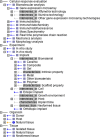Guidelines for managing data and processes in bone and cartilage tissue engineering
- PMID: 24564199
- PMCID: PMC4015954
- DOI: 10.1186/1471-2105-15-S1-S14
Guidelines for managing data and processes in bone and cartilage tissue engineering
Abstract
Background: In the last decades, a wide number of researchers/clinicians involved in tissue engineering field published several works about the possibility to induce a tissue regeneration guided by the use of biomaterials. To this aim, different scaffolds have been proposed, and their effectiveness tested through in vitro and/or in vivo experiments. In this context, integration and meta-analysis approaches are gaining importance for analyses and reuse of data as, for example, those concerning the bone and cartilage biomarkers, the biomolecular factors intervening in cell differentiation and growth, the morphology and the biomechanical performance of a neo-formed tissue, and, in general, the scaffolds' ability to promote tissue regeneration. Therefore standards and ontologies are becoming crucial, to provide a unifying knowledge framework for annotating data and supporting the semantic integration and the unambiguous interpretation of novel experimental results.
Results: In this paper a conceptual framework has been designed for bone/cartilage tissue engineering domain, by now completely lacking standardized methods. A set of guidelines has been provided, defining the minimum information set necessary for describing an experimental study involved in bone and cartilage regenerative medicine field. In addition, a Bone/Cartilage Tissue Engineering Ontology (BCTEO) has been developed to provide a representation of the domain's concepts, specifically oriented to cells, and chemical composition, morphology, physical characterization of biomaterials involved in bone/cartilage tissue engineering research.
Conclusions: Considering that tissue engineering is a discipline that traverses different semantic fields and employs many data types, the proposed instruments represent a first attempt to standardize the domain knowledge and can provide a suitable means to integrate data across the field.
Figures




Similar articles
-
Cartilage and bone tissue engineering using hydrogels.Biomed Mater Eng. 2006;16(4 Suppl):S107-13. Biomed Mater Eng. 2006. PMID: 16823101 Review.
-
Growth Factor and Its Polymer Scaffold-Based Delivery System for Cartilage Tissue Engineering.Int J Nanomedicine. 2020 Aug 14;15:6097-6111. doi: 10.2147/IJN.S249829. eCollection 2020. Int J Nanomedicine. 2020. PMID: 32884266 Free PMC article. Review.
-
Nonwoven membranes for tissue engineering: an overview of cartilage, epithelium, and bone regeneration.J Biomater Sci Polym Ed. 2019 Aug;30(12):1026-1049. doi: 10.1080/09205063.2019.1620592. Epub 2019 Jun 2. J Biomater Sci Polym Ed. 2019. PMID: 31106705
-
Current state of fabrication technologies and materials for bone tissue engineering.Acta Biomater. 2018 Oct 15;80:1-30. doi: 10.1016/j.actbio.2018.09.031. Epub 2018 Sep 22. Acta Biomater. 2018. PMID: 30248515 Review.
-
Biomaterials for tissue engineering.Ann Biomed Eng. 2014 Feb;42(2):323-37. doi: 10.1007/s10439-013-0859-6. Epub 2013 Jul 3. Ann Biomed Eng. 2014. PMID: 23820768 Free PMC article. Review.
Cited by
-
Isolation, identification, and comparison of cartilage stem progenitor/cells from auricular cartilage and perichondrium.Am J Transl Res. 2016 Feb 15;8(2):732-41. eCollection 2016. Am J Transl Res. 2016. PMID: 27158365 Free PMC article.
-
First Proposal of Minimum Information About a Cellular Assay for Regenerative Medicine.Stem Cells Transl Med. 2016 Oct;5(10):1345-1361. doi: 10.5966/sctm.2015-0393. Epub 2016 Jul 12. Stem Cells Transl Med. 2016. PMID: 27405781 Free PMC article.
-
NETTAB 2012 on "Integrated Bio-Search".BMC Bioinformatics. 2014;15 Suppl 1(Suppl 1):S1. doi: 10.1186/1471-2105-15-S1-S1. Epub 2014 Jan 10. BMC Bioinformatics. 2014. PMID: 24564635 Free PMC article.
References
-
- Pennesi G, Scaglione S, Giannoni P, Quarto R. Regulatory influence of scaffolds on cell behavior: how cells decode biomaterials. Curr Pharm Biotechnol. 2011;12(2):151–159. - PubMed
-
- Lammers G, Gilissen C, Nillesen ST, Uijtdewilligen PJ, Wismans RG, Veltman JA, Daamen WF, van Kuppevelt TH. High density gene expression microarrays and gene ontology analysis for identifying processes in implanted tissue engineering constructs. Biomaterials. 2010;31(32):8299–8312. - PubMed
-
- Gruber T. In: Encyclopedia of Database Systems. Liu L and Özsu MT, editor. Springer-Verlag; 2008. Ontology.
-
- Smith B, Ashburner M, Rosse C, Bard J, Bug W, Ceusters W, Goldberg LJ, Eilbeck K, Ireland A, Mungall CJ. OBI Consortium. Leontis N, Rocca-Serra P, Ruttenberg A, Sansone SA, Scheuermann RH, Shah N, Whetzel PL, Lewis S. The OBO Foundry: coordinated evolution of ontologies to support biomedical data integration. Nat Biotechnol. 2007;25(11):1251–1255. - PMC - PubMed
Publication types
MeSH terms
Substances
LinkOut - more resources
Full Text Sources
Other Literature Sources

